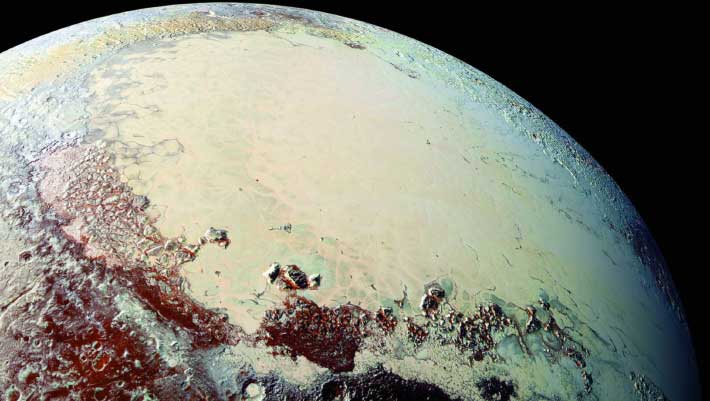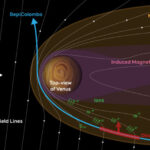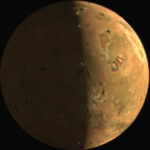Pluto’s surface is dominated by the huge, pear-shaped basin Sputnik Planitia. It appears to be of impact origin, but modeling has not yet explained its peculiar geometry. Planetary scientists at the University of Bern propose an impact mechanism that reproduces the basin’s topographic shape while also explaining its alignment near the Pluto-Charon axis. According to their research, Pluto’s collision with a planetary body about 700 km (435 miles) in diameter produced Sputnik Planitia.
This Pluto mosaic was made from New Horizons LORRI images taken on July 14, 2015, from a distance of 49,700 miles (80,000 km). This view is projected from a point 1,118 miles (1,800 km) above Pluto’s equator, looking northeast over the dark, cratered Cthulhu Regio toward the bright, smooth expanse of icy plains called Sputnik Planum. Pluto’s North Pole is off the image to the left. This mosaic was produced with panchromatic images from the New Horizons LORRI camera, with color overlaid from the Ralph color mapper onboard New Horizons. Image credit: S.A. Stern et al.
In 2015, NASA’s New Horizons spacecraft revealed Pluto’s surface to be geologically complex.
It is dominated by an 1,200 x 2,000 km (746 x 1,243 miles), nitrogen-ice-filled basin named Sputnik Planitia.
Sputnik Planitia is the western part of Tombaugh Regio, Pluto’s famous heart-shaped structure.
The basin is 3 to 4 km (1.9-2.5 miles) lower in elevation than most of the dwarf planet’s surface.
“The bright appearance of Sputnik Planitia is due to it being predominantly filled with white nitrogen ice that moves and convects to constantly smooth out the surface,” said Dr. Harry Ballantyne, a planetary scientist at the University of Bern.
“This nitrogen most likely accumulated quickly after the impact due to the lower altitude.”
“The eastern part of the ‘heart’ is also covered by a similar but much thinner layer of nitrogen ice, the origin of which is still unclear to scientists, but is probably related to Sputnik Planitia.”
“The elongated shape of Sputnik Planitia strongly suggests that the impact was not a direct head-on collision but rather an oblique one,” said Dr. Martin Jutzi, a planetary scientist at the University of Bern.

This high-resolution image of Pluto was taken by New Horizons on July 14. Pluto’s surface sports a remarkable range of subtle colors, enhanced in this view to a rainbow of pale blues, yellows, oranges, and deep reds. Many landforms have their own distinct colors, telling a complex geological and climatological story that scientists have only just begun to decode. Image credit: NASA / Johns Hopkins University Applied Physics Laboratory / Southwest Research Institute.
The authors used their Smoothed Particle Hydrodynamics (SPH) simulation software to digitally recreate such impacts, varying both the composition of Pluto and its impactor, as well as the velocity and angle of the impactor.
These simulations confirmed their suspicions about the oblique angle of impact and determined the composition of the impactor.
“Pluto’s core is so cold that the rocks remained very hard and did not melt despite the heat of the impact, and thanks to the angle of impact and the low velocity, the core of the impactor did not sink into Pluto’s core, but remained intact as a splat on it,” Dr. Ballantyne said.
“Somewhere beneath Sputnik is the remnant core of another massive body, that Pluto never quite digested,” added Dr. Erik Asphaug, a planetary scientist at the University of Arizona.
“This core strength and relatively low velocity were key to the success of these simulations: lower strength would result in a very symmetrical leftover surface feature that does not look like the teardrop shape observed by New Horizons.”
“We are used to thinking of planetary collisions as incredibly intense events where you can ignore the details except for things like energy, momentum and density.”
“But in the distant Solar System, velocities are so much slower, and solid ice is strong, so you have to be much more precise in your calculations. That’s where the fun starts.”
The team’s findings also shed new light on Pluto’s internal structure.
“In fact, a giant impact like the one simulated is much more likely to have occurred very early in Pluto’s history,” the researchers said.
“However, this poses a problem: a giant depression like Sputnik Planitia is expected to slowly move towards the pole of the dwarf planet over time due to the laws of physics, since it has a mass deficit. Yet it is paradoxically near the equator.”
“The previous theorized explanation was that Pluto, like several other planetary bodies in the outer Solar System, has a subsurface liquid water ocean.”
“According to the previous explanation, Pluto’s icy crust would be thinner in the Sputnik Planitia region, causing the ocean to bulge there, and since liquid water is denser than ice, you would end up with a mass surplus that induces migration toward the equator.”
“However, the new study offers an alternative perspective.”
“In our simulations, all of Pluto’s primordial mantle is excavated by the impact, and as the impactor’s core material splats onto Pluto’s core, it creates a local mass excess that can explain the migration toward the equator without a subsurface ocean, or at most a very thin one,” Dr. Jutzi said.
“This novel and inventine origin for Pluto’s heart-shaped feature may lead to a better understanding of Pluto’s origin,” said Dr. Adeene Denton, a planetary scientist at the University of Arizona.
The results were published in the journal Nature Astronomy.
_____
H.A. Ballantyne et al. Sputnik Planitia as an impactor remnant indicative of an ancient rocky mascon in an oceanless Pluto. Nat Astron, published online April 15, 2024; doi: 10.1038/s41550-024-02248-1




